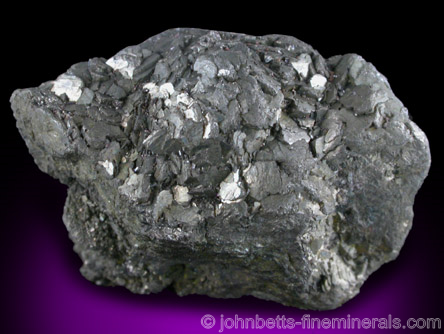The Mineral miargyrite

Miargyrite is an uncommon silver
sulfosalt. Though opaque and with a
metallic luster, it may have slight translucent overtones of dark red, especially when containing arsenic in its
structure which can replace some of the antimony. Arsenic is responsible for lightening up the color, and when the arsenic fully replaces the antimony, the mineral is no longer Miargyrite, but Smithite, a rare sulfosalt with a bright red color and transparency. Miargyrite is named after the Greek word
Meion - "less", and
Argyros - "silver", since it contains a lesser percentage silver than other silver
ores such as
Pyrargyrite.
Color
Lead-gray to nearly black. May have internal dark red reflections or a minor iridescent tarnish.
Crystal System
Monoclinic
Properties
Streak
Red |
Hardness
2 - 2.5 |
Transparency
Opaque |
Specific Gravity
5.1 - 5.3 |
Luster
Metallic |
Cleavage
3,3 |
Fracture
Subconchoidal to uneven |
Tenacity
Brittle |
Crystal Habits
In complex crystals often clustered together in tight groups. Aggregates are often rounded, with individual crystals rare and never large in size. Crystals are often complex, and are usually deeply striated. Other habits include drusy, rosette, grainy, botryoidal in veins, and massive.
Additional Information
Composition
Silver antimony sulfide, sometimes with some arsenic replacing the antimony |
In Group
Sulfides; Sulfosalts |
Striking Features
Color and streak |
Environment
In silver veins of low temperature hydrothermal replacement deposits. |
Rock Type
Sedimentary |
Uses
Miargyrite is an ore of silver.
Noteworthy Localities
The type locality for Miargyrite is Bräunsdorf, Freiberg District, Erzgebirge, Saxony, Germany, where small but lustrous crystals have been found with Quartz. A classic European region for this mineral is Baia Sprie and Baia Mare (the Herja Mine), in Maramureș Co., Romania.
Perhaps the finest specimens of Miargyrite have come from the San Genaro Mine in Huancavelica Department, Peru, where it forms in relatively large examples for this species including thick crystal masses. In the U.S., crystallized examples as well as silvery masses come from the Kelly Mine, Randsburg, Kern Co., California.
Distingushing Similar Minerals
Pyrargyrite - Darker colored streak; otherwise difficult to distiniguish.